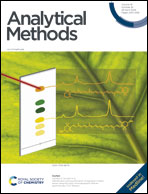Simple and convenient preconcentration procedure for the isotopic analysis of uranium in seawater†
Abstract
The demand for monitoring anthropogenic U isotopes, 236U and 233U, in seawater will continue to increase due to radioecological issues and the need for tools for environmental dynamics research. In response to this growing demand, herein, a novel and simple method was developed for the collection of U isotopes in seawater, both in the laboratory and field, using a fabric-like amidoxime adsorbent. The results from the adsorption studies showed that the optimum conditions for processing seawater in a glass beaker were as follows: seawater pH 4, amidoxime adsorbent 0.20 mmol per 500 g seawater and an adsorption time of 9 hours. Alternatively, when using a closed polyethylene container in experiments on-board a ship and using the same ratio of adsorbent to seawater as in the beaker experiment in the laboratory, the optimum conditions were as follows: seawater pH 8 and an adsorption time of 24 hours. Under the above-mentioned conditions, more than 95% of the U underwent adsorption in both the beaker and the polyethylene container experiments. In the case of analyte desorption, more than 80% of U in seawater was recovered using 2–3 mol dm−3 HCl or HNO3 as the eluent. Thus, it was concluded that the amidoxime adsorbent can serve as a simple and effective pre-concentration method for the ultra-trace monitoring of U isotopes in seawater.

- This article is part of the themed collection: Analytical Methods HOT Articles 2024


 Please wait while we load your content...
Please wait while we load your content...